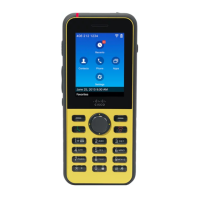Set up Flexible DSCP
Procedure
Step 1
In Cisco Unified Communications Manager Administration, go to System > Service Parameters.
Step 2
In Clusterwide Parameters (System - Location and Region), set Use Video BandwidthPool for Immersive
Video Calls to False.
Step 3
In Clusterwide Parameters (Call Admission Control), set Video Call QoS Marking Policy to Promote to
Immersive.
Step 4
Save your changes.
802.11 Standards for WLAN Communications
Wireless LANs must follow the Institute of Electrical and Electronics Engineers (IEEE) 802.11 standards that
define the protocols that govern all Ethernet-based wireless traffic. The wireless phones support the following
standards:
•
802.11a: Uses the 5 GHz band that provides more channels and improved data rates by using OFDM
technology. Dynamic Frequency Selection (DFS) and Transmit Power Control (TPC) support this
standard.
•
802.11b: Specifies the radio frequency (RF) of 2.4 Ghz for both transmission and receipt of data at lower
data rates (1, 2, 5.5, 11 Mbps).
•
802.11d: Enables access points to advertise their currently supported radio channels and transmit power
levels. The 802.11d-enabled client then uses that information to determine the channels and powers to
use. The phone requires World mode (802.11d) to determine which channels are legally allowed for any
given country. For supported channels, see the table that follows. Ensure that 802.11d is properly
configured on the Cisco IOS Access Points or Cisco Unified Wireless LAN Controller.
•
802.11e: Defines a set of Quality of Service (QoS) enhancements for wireless LAN applications.
•
802.11g: Uses the same unlicensed 2.4 Ghz band as 802.11b, but extends the data rates to provide greater
performance by using Orthogonal Frequency Division Multiplexing (OFDM) technology. OFDM is a
physical-layer encoding technology for transmission of signals through use of RF.
•
802.11h: Supports 5 GHz spectrum and transmit power management. Provides DFS and TPC to the
802.11a Media Access Control (MAC).
•
802.11i: Specifies security mechanisms for wireless networks.
•
802.11n: Uses the radio frequency of 2.4 GHz or 5 GHz for both transmission and receipt of data with
speeds up to 150 Mbps, and enhances data transfer through the use of multiple input, multiple output
(MIMO) technology, channel bonding, and payload optimization.
Cisco Wireless IP Phone 8821 and 8821-EX Administration Guide for Cisco Unified Communications Manager
23
VoIP Networks
802.11 Standards for WLAN Communications

